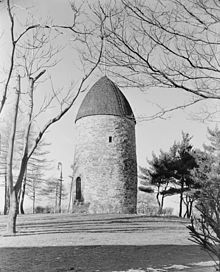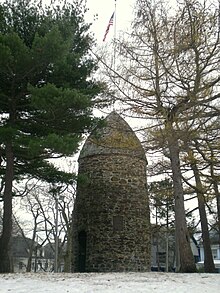
Paul Revere was an American silversmith, engraver, folk hero, early industrialist, Sons of Liberty member, and Patriot. He is best known for his midnight ride to alert the colonial militia in April 1775 to the approach of British forces before the battles of Lexington and Concord, as dramatized in Henry Wadsworth Longfellow's 1861 poem, "Paul Revere's Ride".
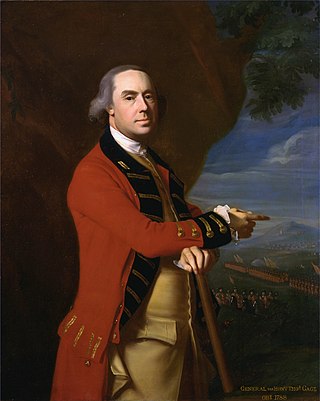
General Thomas Gage was a British Army general officer and colonial official best known for his many years of service in North America, including his role as British commander-in-chief in the early days of the American Revolution.
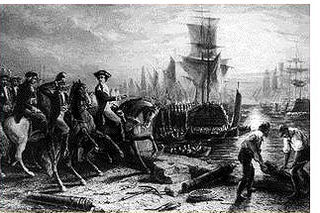
The siege of Boston was the opening phase of the American Revolutionary War. In the siege, American patriot militia led by newly-installed Continental Army commander George Washington prevented the British Army, which was garrisoned in Boston, from moving by land. Both sides faced resource, supply, and personnel challenges over during the siege. British resupply and reinforcement was limited to sea access, which was impeded by American vessels. The British ultimately abandoned Boston after eleven months, moving their troops and equipment north, to Nova Scotia.

Samuel Prescott was an American physician and a Massachusetts Patriot during the American Revolutionary War. He is best known for his role in Paul Revere's "midnight ride" to warn the townspeople of Concord, Massachusetts, of the impending British army move to capture guns and gunpowder kept there at the beginning of the American Revolution. He was the only participant in the ride to reach Concord.
Thomas Oliver was the last royal lieutenant-governor of the Province of Massachusetts Bay.

The Boston campaign was the opening campaign of the American Revolutionary War, taking place primarily in the Province of Massachusetts Bay. The campaign began with the Battles of Lexington and Concord on April 19, 1775, in which the local colonial militias interdicted a British government attempt to seize military stores and leaders in Concord, Massachusetts. The entire British expedition suffered significant casualties during a running battle back to Charlestown against an ever-growing number of militia.

The Gunpowder Incident was a conflict early in the American Revolutionary War between Lord Dunmore, the Royal Governor of the Colony of Virginia, and militia led by Patrick Henry. On April 20, 1775, one day after the Battles of Lexington and Concord, Lord Dunmore ordered the removal of the gunpowder from the magazine in Williamsburg, Virginia to a Royal Navy ship.

The Raid of Nassau was a naval operation and amphibious assault by American forces against the British port of Nassau, Bahamas, during the American Revolutionary War. The raid, designed to resolve the issue of gunpowder shortages, resulted in the seizure of two forts and large quantities of military supplies before the raiders drew back to New England, where they fought an unsuccessful engagement with a British frigate.

The Battles of Lexington and Concord were some of the leading military engagements of the American Revolutionary War. The battles were fought on April 19, 1775, in Middlesex County, Province of Massachusetts Bay, within the towns of Lexington, Concord, Lincoln, Menotomy, and Cambridge. They marked the outbreak of armed conflict between the Kingdom of Great Britain and Patriot militias from America's thirteen colonies.
Powderhouse Productions is an American television production company established in 1994.
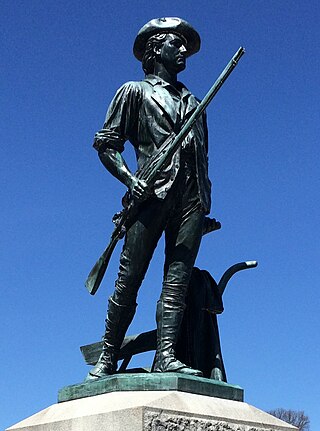
Isaac Davis was a gunsmith and a militia officer who commanded a company of Minutemen from Acton, Massachusetts, during the first battle of the American Revolutionary War. In the months leading up to the Revolution, Davis set unusually high standards for his company in terms of equipment, training, and preparedness. His company was selected to lead the advance on the British Regulars during the Battle of Concord because his men were entirely outfitted with bayonets. During the American advance on the British at the Old North Bridge, Davis was among the first killed and was the first American officer to die in the Revolution.

The Battle of Kemp's Landing, also known as the Skirmish of Kempsville, was a skirmish in the American Revolutionary War that occurred on November 15, 1775. Militia companies from Princess Anne County in the Province of Virginia assembled at Kemp's Landing to counter British troops under the command of Virginia's last colonial governor, John Murray, Lord Dunmore, that had landed at nearby Great Bridge. Dunmore was investigating rumors of Patriot troop arrivals from North Carolina that turned out to be false; he instead moved against the Princess Anne militia, defeating their attempt at an ambush and routing them.

Powder House Square is a neighborhood and landmark rotary in Somerville, Massachusetts, United States. It is also known locally as Powder House Circle. It is the 6-way intersection of College Avenue, Broadway, Warner Street, and Powder House Boulevard. Powder House Square stands at the southern tip of Tufts University's main Somerville/Medford campus, and borders the northern edge of Nathan Tufts Park. The square takes its name from the 18th century Powder House which overlooks the rotary from Nathan Tufts Park.

The Massachusetts Provincial Congress (1774–1780) was a provisional government created in the Province of Massachusetts Bay early in the American Revolution. Based on the terms of the colonial charter, it exercised de facto control over the rebellious portions of the province, and after the British withdrawal from Boston in March 1776, the entire province. When Massachusetts Bay declared its independence in 1776, the Congress continued to govern under this arrangement for several years. Increasing calls for constitutional change led to a failed proposal for a constitution produced by the Congress in 1778, and then a successful constitutional convention that produced a constitution for the state in 1780. The Provincial Congress came to an end with elections in October 1780.

The Burning of Norfolk was an incident that occurred on January 1, 1776, during the American Revolutionary War. British Royal Navy ships in the harbor of Norfolk, Virginia, began shelling the town, and landing parties came ashore to burn specific properties. The town, whose significantly Loyalist population had fled, was occupied by Patriot forces from Virginia and North Carolina. Although the Patriots worked to drive off the British landing parties, they did nothing to impede the progress of the flames, and began burning and looting Loyalist-owned property instead.

Minutemen were members of the organized New England colonial militia companies trained in weaponry, tactics, and military strategies during the American Revolutionary War. They were known for being ready at a minute's notice, hence the name. Minutemen provided a highly mobile, rapidly deployed force that enabled the colonies to respond immediately to military threats. They were an evolution from the prior colonial rapid-response units.
Thaddeus Bowman was the last scout sent out by Capt. John Parker at Lexington, Massachusetts, but the only one to find the approaching British troops and get back to warn the militia on the first day of the American Revolution.
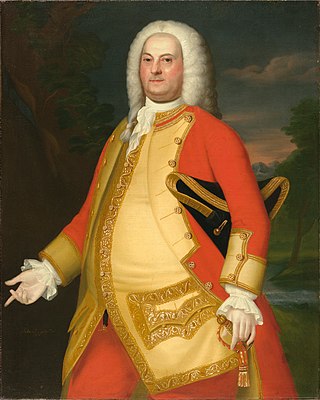
Major-General William Brattle was an American politician, lawyer, cleric, physician and military officer who served as the Attorney General of Massachusetts from 1736 to 1738. Brattle is best known for his actions during the American Revolution, in which he initially aligned himself with the Patriot cause before transferring his allegiances towards the Loyalist camp, which led to the eventual downfall of his fortunes.

The Capture of Fort William and Mary took place in Portsmouth, New Hampshire, on December 14, 1774, when local Patriots led by John Langdon stormed Fort William and Mary guarding the mouth of the busy seaport. They overcame a six-man caretaker detachment) and seized the garrison's powder, which was distributed through several towns in the colony for potential use in the looming struggle against Great Britain. On December 15, 1774, patriots led by John Sullivan again raided the fort, this time seizing numerous cannons, later used in the pivotal Battle of Bunker Hill.
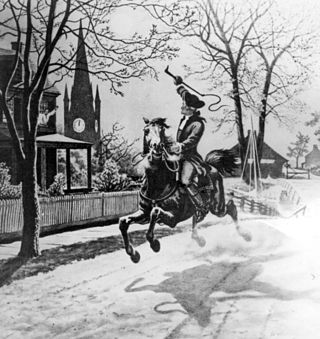
The Midnight Ride was the alert to the American colonial militia in April 1775 to the approach of British forces before the battles of Lexington and Concord.
